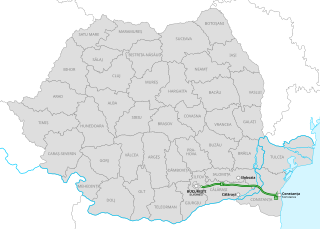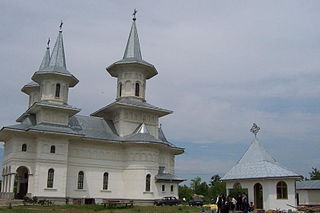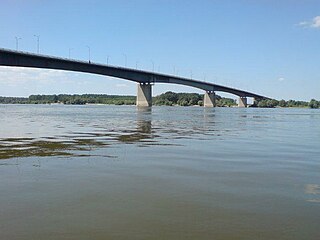
Cernavodă is a town in Constanța County, Northern Dobruja, Romania with a population of 20,514.

The Danube–Black Sea Canal is a navigable canal in Romania, which runs from Cernavodă on the Danube river, via two branches, to Constanța and Năvodari on the Black Sea. Administered from Agigea, it is an important part of the waterway link between the North Sea and the Black Sea via the Rhine–Main–Danube Canal. The main branch of the canal, with a length of 64.4 km (40.0 mi), which connects the Port of Cernavodă with the Port of Constanța, was built in 1976–1984, while the northern branch, known as the Poarta Albă–Midia Năvodari Canal, with a length of 31.2 km (19.4 mi), connecting Poarta Albă and the Port of Midia, was built between 1983 and 1987.

Fetești is a city in Ialomița County, Muntenia, Romania. It is located in the Bărăgan plain, on the Borcea branch of the Danube. Fetești has the second largest population in Ialomița, after Slobozia.

Trajan's Bridge, also called Bridge of Apollodorus over the Danube, was a Roman segmental arch bridge, the first bridge to be built over the lower Danube and one of the greatest achievements in Roman architecture. Though it was only functional for 165 years, it is often considered to have been the longest arch bridge in both total and span length for more than 1,000 years.

The Ialomița is a river of Southern Romania. It rises from the Bucegi Mountains in the Carpathians. It discharges into the Borcea branch of the Danube in Giurgeni. It is 417 km (259 mi) long, and its basin area is 10,350 km2 (4,000 sq mi). Its average discharge at the mouth is 45 m3/s (1,600 cu ft/s). Ialomița County takes its name from this river.

The A2 motorway, also known as The Motorway of the Sun, is a motorway in Romania which links Bucharest with Constanța, a city-port on the shore of the Black Sea, where it merges after an interchange into the A4 motorway. It is 206 km long, and has been operational on its entire length since November 2012.

Anghel Saligny was a Romanian engineer, most famous for designing the Fetești-Cernavodă railway bridge (1895) over the Danube, the longest bridge in Europe at that time. He also designed the storage facilities in Constanța seaport, one of the earliest examples of reinforced concrete architecture in Europe.

Liești is the third-largest commune of Galați County, Western Moldavia, Romania on the confluence of the Siret and Bârlad rivers, very close to Tecuci (28 km) and Galați (52 km). It is composed of two villages, Liești and Șerbănești. The latter is the southernmost part of the commune.

The Danube Bridge is a steel truss bridge over the Danube River connecting the Bulgarian bank to the south with the Romanian bank to the north and the cities of Ruse and Giurgiu respectively. It is one of only two bridges connecting Romania and Bulgaria, the other one being the New Europe Bridge between the cities of Vidin and Calafat.
Balta Ialomiței is an island on the Danube, located in Ialomița County and Călărași County, Romania. It is surrounded by two branches of the Danube, named "Borcea" and "Dunărea Veche". Originally, a wetland, the island was covered with marshes, woods, lakes, and ponds, but some of the land was reclaimed for agriculture. Occasionally, some of these regions are still flooded. The A2 freeway passes through this island. The island has an area of 831.3 km2 (321.0 sq mi), with a length of 94 km (58 mi) and a width of 5 to 12.5 kilometres. The average height is 10 to 17 metres.

The Cernavodă Bridge is a complex of two freeway-railroad truss bridges in Romania, across the Danube River, connecting the cities of Cernavodă and Fetești, between the regions of Dobruja and Muntenia.

Făcăeni is a commune in Ialomița County, Muntenia, Romania. Its population was 5,953 at the 2002 census. The commune is composed of two villages, Făcăeni and Progresu.

Constantine's Bridge was a Roman bridge over the Danube used to reconquer Dacia. It was completed in 328 AD and remained in use for four decades.

The Giurgeni–Vadu Oii Bridge is a bridge in Romania, over the Danube river, between Giurgeni commune and Vadu Oii village on the DN2A (E60) national road. Situated on River - Km 237,8, it connects the regions of Muntenia and Dobruja.

The Brăila Bridge is a road suspension bridge in Romania over the Danube river, between Brăila, a major city in eastern Romania, and the opposite bank of the river in Tulcea County, on the DN2S national road. It is the first bridge over the maritime Danube sector and the fourth bridge over the Romanian section of the river. At nearly 2 km in length, it is the largest bridge over the Danube, and the third longest suspension bridge in the European Union. The bridge improves road traffic accessibility of the Galați-Brăila area to Constanța and Tulcea, and connections of the Moldavia and Muntenia regions with Dobruja. The European Union co-funded the project with €363 million from Cohesion Policy funds.





















